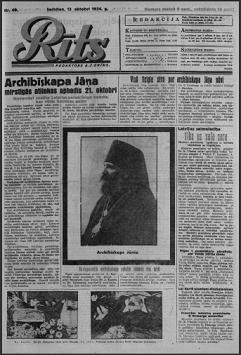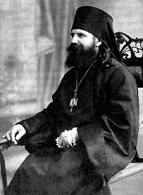Difference between revisions of "John (Pommers) of Riga"
EricJansson (talk | contribs) (→Sources) |
EricJansson (talk | contribs) (→Sources) |
||
| Line 54: | Line 54: | ||
*[http://www.orthodox.net/russiannm/john-archbishop-and-hieromartyr-of-riga.html John Archbishop and Hieromartyr of Riga] | *[http://www.orthodox.net/russiannm/john-archbishop-and-hieromartyr-of-riga.html John Archbishop and Hieromartyr of Riga] | ||
*[http://www.trueorthodoxy.info/los_stjohn_riga.shtml St. John of Riga] | *[http://www.trueorthodoxy.info/los_stjohn_riga.shtml St. John of Riga] | ||
| − | *[http://www.kra.lv/Latviski/Raksti/Sv_R-Janis.pdf "St. John of Riga and His Icon," article | + | *[http://www.kra.lv/Latviski/Raksti/Sv_R-Janis.pdf "St. John of Riga and His Icon," article (in Latvian) published by the Latvian Christian Academy] |
| − | *[http://www.jmp.ru/jmp/06/07-06/11.htm "Holy Martyr John ( | + | *[http://www.jmp.ru/jmp/06/07-06/11.htm "Holy Martyr John (Pommers), Archbishop of Riga and Latvia," article (in Russian) and photographs published by Journal of the Moscow Patriarchate] |
==External links== | ==External links== | ||
Revision as of 20:41, August 25, 2010
Our father among the saints, the holy martyr John (Pommers) of Riga, also Jānis (Pommers) of Riga (Latvian: Svētais svētmoceklis Rīgas Jānis; Russian: Святой Священномученик Иоанн Рижский) was Archbishop of Riga and Latvia (1921-1934).
Contents
Life
He was born Jānis Pommers in 1876 to a Latvian peasant family in the area of Lazdona, a village in the Vidzeme region of Latvia, near the town of Madona. St. John was a highly energetic pastor whose service as Archbishop of Riga and Latvia often bridged Latvia's ethnic divisions, particularly those between Russians and Latvians, and included political engagement even to the extent that he became a Member of Parliament in Latvia's national assembly, the Saeima.
St. John was martyred brutally in the night of October 12, 1934, at the archbishop's residence at Kish Lake (Latvian: Ķīšezers) outside Riga's city center. Although his assassins were never apprehended, they have widely been assumed to be agents of the Bolshevik regime in neighboring Soviet Russia, whose persecutions of the Orthodox Church the saint had already suffered earlier during a turbulent period of service as Archbishop of Penza and Saransk (1918-1921). Earlier still, he served as auxiliary Bishop of Minsk (1911-1912) and Bishop of Priazovye (1913-1917).
In 1921, the year St. John returned to Latvia, St. Tikhon of Moscow, then Patriarch of the Russian Orthodox Church, granted independence to the Latvian Orthodox Church. Therefore St. John became the first Latvian archbishop. Jurisdictional difficulties followed his martyrdom, lasting from 1936 to 1940, and the suffering of the Latvian Orthodox Church increased again during Latvia's Soviet occupation, which lasted from the Second World War until 1991. In 1992, the Latvian Orthodox Church became semi-autonomous, with a high degree of independence but lacking autocephaly. Thus, the contemporary pastoral successor to St. John of Riga bears the title Metropolitan.
The day of the St. John's martyrdom is hisfeast day, October 12. His canonization occurred locally in 2001, having been recognized already many years before by the Russian Orthodox Church Outside Russia.
Despite the terrible nature of the saint's martyrdom, during which he suffered both bullet wounds and burning, St. John's body was found intact in 2003.
Links to Orthodoxy in America and China
St. Tikhon of Moscow, who as Patriarch of the Russian Orthodox Church blessed and strengthened St. John's service in Riga and Latvia, was one of the first Orthodox bishops to do major work in North America.
One of St. John's early successors in Riga was John Garklavs (Latvian: Jānis Garklavs), who became Bishop of Riga and All Latvia in 1943 before fleeing the violence of war with his family one year later. He later served as Bishop of Detroit and Cleveland (1949-1955) and Archbishop of Chicago (1957-1978) in the American Metropolia (now the Orthodox Church in America).
In addition to those relics of St. John which remain in the keeping of the Latvian Orthodox Church, relics of the saint were also laid in the altar of the Dormition church in Beijing, China, which was consecrated on October 13, 2009 and is located on the grounds of the old Russian Orthodox Mission in China.
Homilies and Writings of St. John
- "The Inevitability of Suffering" (English translation)
- "Pray for the Reposed!" (English translation)
- "A New Place" (English translation)
- "Новое Место" (Russian)
Predecessors and Successors in the Episcopate
| John (Pommers) of Riga | ||
|---|---|---|
| Preceded by: ? |
Bishop of Minsk auxiliary 1911-1912 |
Succeeded by: ? |
| Preceded by: ? |
Bishop of Priazovye 1913-1917 |
Succeeded by: ? |
| Preceded by: ? |
Archbishop of Penza and Saransk 1918-1921 |
Succeeded by: ? |
| Preceded by: ? |
Archbishop of Riga and All Latvia 1921-1934 |
Succeeded by: ? |
Sources
Keller, Ludmilla (translated by Fr. German Ciuba), "The Life and Passion of Saint John (Pommer) Archbishop of Riga and Latvia," The St. John of Kronstadt Press, 1997; ISBN 0-912927-81-X
- John Archbishop and Hieromartyr of Riga
- St. John of Riga
- "St. John of Riga and His Icon," article (in Latvian) published by the Latvian Christian Academy
- "Holy Martyr John (Pommers), Archbishop of Riga and Latvia," article (in Russian) and photographs published by Journal of the Moscow Patriarchate
External links
- Latvian Orthodox Church (official website)
- A Thousand Years of Orthodox Latvia (1010-2010)
- Latvian Orthodox Church at Wikipedia.
E-archived newspaper reports on St. John of Riga
- E-archival pages of Latvian newspaper "Rīts," Saturday, October 13, 1934
- E-archival pages of Latvian newspaper "Rīts," Sunday, October 14, 1934
- E-archival pages of Latvian newspaper "Rīts," Monday, October 15, 1934
- E-archival pages of Latvian newspaper "Rīts," Tuesday, October 16, 1934
- E-archival pages of Latvian newspaper "Rīts," Wednesday, October 17, 1934
- E-archival pages of Latvian newspaper "Rīts," Thursday, October 18, 1934
- E-archival pages of Latvian newspaper "Rīts," Friday, October 19, 1934
- E-archival pages of Latvian newspaper "Rīts," Saturday, October 20, 1934
- E-archival pages of Latvian newspaper "Rīts," Sunday, October 21, 1934
- E-archival pages of Latvian newspaper "Latvijas Kareivis," October 14, 1934
- E-archival page of Latvian newspaper "Jaunākās Ziņas," July 15, 1936
- E-archival page of Latvian newspaper "Jaunākās Ziņas," October 12, 1936
Categories > Church History
Categories > Church History
Categories > Liturgics > Feasts
Categories > Liturgics > Feasts
Categories > People > Clergy > Bishops
Categories > People > Clergy > Bishops > Bishops by century > 20th-century bishops
Categories > People > Clergy > Bishops > Bishops by city > Bishops of Minsk
Categories > People > Clergy > Bishops > Bishops by city > Bishops of Penza and Saransk
Categories > People > Clergy > Bishops > Bishops by city > Bishops of Priazovye
Categories > People > Clergy > Bishops > Bishops by city > Bishops of Riga
Categories > People > Saints
Categories > People > Saints > Saints by century > 20th-century saints

